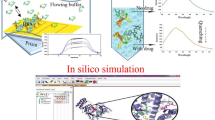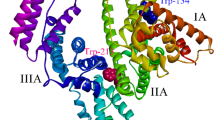Abstract
In this paper, a novel chitosan oligosaccharides derivative—chitosan oligosaccharides–kojic acid graft copolymer (COS/KA), COS, and KA were selected to investigate the binding to bovine serum albumin (BSA) using UV–Vis spectroscopy, fluorescence, synchronous fluorescence, and circular dichroism (CD) at pH 7.4. The results indicated that the tryptophan residues of BSA to the distance of COS/KA, COS, and KA were <8 nm, the quenching constants K0 were decreased, and the value of Kq were much >2.0 × 1010 L mol−1 s−1 for COS/KA–BSA, COS–BSA, and KA–BSA at 298, 302, 306, 310 K, respectively, those confirmed that the quenching process belongs to static quenching. The thermodynamic parameters ∆H°, ΔG°, ΔS° at different temperatures were calculated and indicated that hydrophobic and electrostatic forces played important roles in the binding process, and the enhanced binding affinity mainly associated with the increase of the hydrophobicity. Moreover, the CD data demonstrated that the secondary structure of BSA was slightly altered in the presence of COS/KA, COS, and KA, with different reduced α-helix contents (46.30 ± 0.20, 48.60 ± 0.40, 50.70 ± 0.20), respectively. The work provides basic data for the binding mechanism of COS/KA with BSA in vitro.








Similar content being viewed by others
References
Celiktas OY, Kocabas E, Bedir E, Sukan FV, Ozek T, Baser K (2007) Antimicrobial activities of methanol extracts and essential oils of Rosmarinus officinalis, depending on location and seasonal variations. Food Chem 100(2):553–559. doi:10.1016/j.foodchem.2005.10.011
Jacob C, Mathiasen L, Powell D (2010) Designing effective messages for microbial food safety hazards. Food Control 21(1):1–6. doi:10.1016/j.foodcont.2009.04.011
Kim J, Marshall MR, Wei C-i (1995) Antibacterial activity of some essential oil components against five foodborne pathogens. J Agric Food Chem 43(11):2839–2845. doi:10.1021/jf00059a013
Vattem DA, Lin YT, Labbe RG, Shetty K (2004) Phenolic antioxidant mobilization in cranberry pomace by solid-state bioprocessing using food grade fungus Lentinus edodes and effect on antimicrobial activity against select food borne pathogens. Innov Food Sci Emerg Technol 5(1):81–91. doi:10.1016/j.ifset.2003.09.002
Cho Y-S, Lee S-H, Kim S-K, Ahn C-B, Je J-Y (2011) Aminoethyl-chitosan inhibits LPS-induced inflammatory mediators, iNOS and COX-2 expression in RAW264. 7 mouse macrophages. Process Biochem 46(2):465–470. doi:10.1016/j.procbio.2010.09.019
Jeon Y-J, Kim S-K (2000) Production of chitooligosaccharides using an ultrafiltration membrane reactor and their antibacterial activity. Carbohydr Polym 41(2):133–141. doi:10.1016/S0144-8617(99)00084-3
Xia W, Liu P, Zhang J, Chen J (2011) Biological activities of chitosan and chitooligosaccharides. Food Hydrocolloids 25(2):170–179. doi:10.1016/j.foodhyd.2010.03.003
Qin C, Zhou B, Zeng L, Zhang Z, Liu Y, Du Y, Xiao L (2004) The physicochemical properties and antitumor activity of cellulase-treated chitosan. Food Chem 84(1):107–115. doi:10.1016/S0308-8146(03)00181-X
Chen JS, Wei C-I, Rolle RS, Otwell WS, Balaban MO, Marshall MR (1991) Inhibitory effect of kojic acid on some plant and crustacean polyphenol oxidases. J Agric Food Chem 39(8):1396–1401. doi:10.1021/jf00008a008
Aytemir MD, Özçelik B (2010) A study of cytotoxicity of novel chlorokojic acid derivatives with their antimicrobial and antiviral activities. Eur J Med Chem 45(9):4089–4095. doi:10.1016/j.ejmech.2010.05.069
Liu X, Xia W, Jiang Q, Xu Y, Yu P (2013) Synthesis, characterization, and antimicrobial activity of kojic acid grafted chitosan oligosaccharide. J Agric Food Chem 62(1):297–303. doi:10.1021/jf404026f
Giess F, Friedrich MG, Heberle J, Naumann RL, Knoll W (2004) The Protein-Tethered Lipid Bilayer: a Novel Mimic of the Biological Membrane. Biophys J 87(5):3213–3220. doi:10.1529/biophysj.104.046169
Parker M, Pattus F, Tucker A, Tsernoglou D (1989) Structure of the membrane-pore-forming fragment of colicin A. Nature 337:93–96. doi:10.1038/337093a0
Bi S, Song D, Kan Y, Xu D, Tian Y, Zhou X, Zhang H (2005) Spectroscopic characterization of effective components anthraquinones in Chinese medicinal herbs binding with serum albumins. Spectrochim Acta Part A Mol Biomol Spectrosc 62(1):203–212. doi:10.1016/j.saa.2004.12.049
Ravindran A, Singh A, Raichur AM, Chandrasekaran N, Mukherjee A (2010) Studies on interaction of colloidal Ag nanoparticles with bovine serum albumin (BSA). Colloids Surf, B 76(1):32–37. doi:10.1016/j.colsurfb.2009.10.005
Wang F, Huang W, Dai Z (2008) Spectroscopic investigation of the interaction between riboflavin and bovine serum albumin. J Mol Struct 875(1):509–514. doi:10.1016/j.molstruc.2007.05.034
Yang Q, Liang J, Han H (2009) Probing the interaction of magnetic iron oxide nanoparticles with bovine serum albumin by spectroscopic techniques. J Phys Chem B 113(30):10454–10458. doi:10.1021/jp904004w
Wu T, Wu Q, Guan S, Su H, Cai Z (2007) Binding of the environmental pollutant naphthol to bovine serum albumin. Biomacromolecules 8(6):1899–1906. doi:10.1021/bm061189v
Chi Z, Liu R, Teng Y, Fang X, Gao C (2010) Binding of oxytetracycline to bovine serum albumin: spectroscopic and molecular modeling investigations. J Agric Food Chem 58(18):10262–10269. doi:10.1021/jf101417w
Mote U, Bhattar S, Patil S, Kolekar G (2010) Interaction between felodipine and bovine serum albumin: fluorescence quenching study. Luminescence 25(1):1–8. doi:10.1002/bio.1130
Zhang G, Zhao N, Hu X, Tian J (2010) Interaction of alpinetin with bovine serum albumin: probing of the mechanism and binding site by spectroscopic methods. Spectrochim Acta Part A Mol Biomol Spectrosc 76(3):410–417. doi:10.1016/j.saa.2010.04.009
Bourassa P, Kanakis C, Tarantilis P, Pollissiou M, Tajmir-Riahi H (2010) Resveratrol, Genistein, and Curcumin Bind Bovine Serum Albumin†. J Phys Chem B 114(9):3348–3354. doi:10.1021/jp9115996
Hu Y-J, Liu Y, Wang J-B, Xiao X-H, Qu S-S (2004) Study of the interaction between monoammonium glycyrrhizinate and bovine serum albumin. J Pharm Biomed Anal 36(4):915–919. doi:10.1016/j.jpba.2004.08.021
Liu X-F, Xia Y-M, Fang Y (2005) Effect of metal ions on the interaction between bovine serum albumin and berberine chloride extracted from a traditional Chinese Herb coptis chinensis franch. J Inorg Biochem 99(7):1449–1457. doi:10.1016/j.jinorgbio.2005.02.025
Yuan T, Weljie AM, Vogel HJ (1998) Tryptophan fluorescence quenching by methionine and selenomethionine residues of calmodulin: orientation of peptide and protein binding. Biochemistry 37(9):3187–3195. doi:10.1021/bi9716579
Li D, Zhu J, Jin J (2007) Spectrophotometric studies on the interaction between nevadensin and lysozyme. J Photochem Photobiol, A 189(1):114–120. doi:10.1016/j.jphotochem.2007.01.017
Xie M-X, Long M, Liu Y, Qin C, Wang Y-D (2006) Characterization of the interaction between human serum albumin and morin. Biochimica et Biophysica Acta (BBA)-General Subjects 1760(8): 1184–1191.doi: 10.1016/j.bbagen.2006.03.026
Ware WR (1962) Oxygen quenching of fluorescence in solution: an experimental study of the diffusion process. J Phys Chem 66(3):455–458. doi:10.1021/j100809a020
Xie M-X, Xu X-Y, Wang Y-D (2005) Interaction between hesperetin and human serum albumin revealed by spectroscopic methods. Biochimica et Biophysica Acta (BBA)-General Subjects 1724 (1): 215–224.doi: 10.1016/j.bbagen.2005.04.009
Wang Y-Q, Zhang H-M, Zhang G-C, Tao W-H, Tang S-H (2007) Interaction of the flavonoid hesperidin with bovine serum albumin: a fluorescence quenching study. J Iumin 126(1):211–218. doi:10.1016/j.jlumin.2006.06.013
Horrocks Jr WD, Peter Snyder A (1981) Measurement of distance between fluorescent amino acid residues and metal ion binding sites. Quantitation of energy transfer between tryptophan and terbium (III) or europium (III) in thermolysin. Biochem Biophys Res Commun 100 (1):111–117.doi: 10.1016/S0006-291X(81)80070-8
Kurittu J, Lönnberg S, Virta M, Karp M (2000) A group-specific microbiological test for the detection of tetracycline residues in raw milk. J Agric Food Chem 48(8):3372–3377. doi:10.1021/jf9911794
Li D, Zhu M, Xu C, Ji B (2011) Characterization of the baicalein–bovine serum albumin complex without or with Cu2+ or Fe3+ by spectroscopic approaches. Eur J Med Chem 46(2):588–599. doi:10.1016/j.ejmech.2010.11.038
Li S, Huang K, Zhong M, Guo J, Wang W-z, Zhu R (2010) Comparative studies on the interaction of caffeic acid, chlorogenic acid and ferulic acid with bovine serum albumin. Spectrochim Acta Part A Mol Biomol Spectrosc 77(3):680–686. doi:10.1016/j.saa.2010.04.026
Congdon RW, Muth GW, Splittgerber AG (1993) The binding interaction of Coomassie blue with proteins. Anal Biochem 213(2):407–413. doi:10.1006/abio.1993.1439
Lu J-Q, Jin F, Sun T-Q, Zhou X-W (2007) Multi-spectroscopic study on interaction of bovine serum albumin with lomefloxacin–copper (II) complex. Int J Biol Macromol 40(4):299–304. doi:10.1016/j.ijbiomac.2006.08.010
Acknowledgments
We thank the staff at our laboratory for the assistance they have provided in this study. This research was financially supported by the Twelfth Five Year National Science and Technology Plan of rural field research mission contract (2011BAD23B00), and the Fund Project for Transformation of Scientific and Technological Achievements of Jiangsu Province (BA2009082).
Conflict of interest
None.
Compliance with Ethics Requirements
This article does not contain any studies with human or animal subjects.
Author information
Authors and Affiliations
Corresponding author
Rights and permissions
About this article
Cite this article
Liu, X., Xia, W., Jiang, Q. et al. Binding of a novel bacteriostatic agent—chitosan oligosaccharides–kojic acid graft copolymer to bovine serum albumin: spectroscopic and conformation investigations. Eur Food Res Technol 240, 109–118 (2015). https://doi.org/10.1007/s00217-014-2312-y
Received:
Revised:
Accepted:
Published:
Issue Date:
DOI: https://doi.org/10.1007/s00217-014-2312-y




